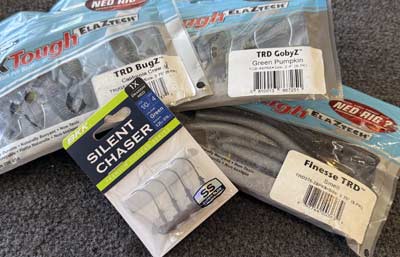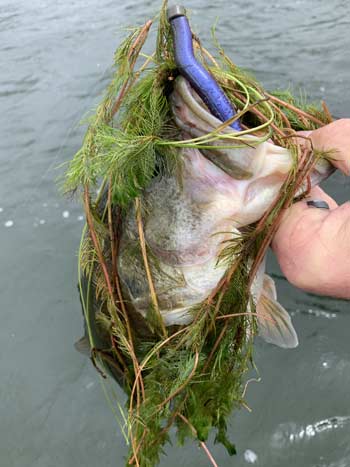
It's been a few years since the finesse rig known as the Ned Rig hit the bass fishing world with authority. When it first became mainstream, it quickly proved to be a great way to catch both numbers of bass and big ones. Now that it's been around for a while, the Ned Rig is here to stay and is a standard fishing technique, along with the drop-shot, shaky head, and other finesse rigs.
Check out this complete guide on fishing with Ned Rigs, whether you're new to the technique or just looking to improve.
Plenty of Options for Soft Plastics and Jigheads
When the Ned Rig first hit the scene, the go-to was a short, soft plastic bait roughly three inches long, such as a 5-inch stick bait cut in half or the ever-popular Z-Man Finesse TRD. These do-nothing baits are perfect for a Ned Rig, but there are now many more sizes and shapes that you can include in your fishing.
Z-Man's ultra-durable ElaZtech plastic remains the standard for most Ned Rig anglers, offering a variety of shapes to choose from. From small beaver-style baits to craws and more, they have a shape for every situation. The soft plastic material they use is also very buoyant, giving the baits a unique stand-up look at rest along the bottom, which can trigger more bites.
Other brands also make a host of soft plastics that work well for Ned Rigs, including straight worms, creature baits, and more. The variety of baits allows you to match the forage you are trying to mimic. Go beyond just the straight finesse worm and try something new while still capitalizing on the effectiveness of a Ned Rig.
Aside from the soft plastics, many brands now produce jigheads for this type of fishing. Z-Man is still king, and they have plenty of options, but one popular alternate choice is the BKK Draggin' Ned jighead, which has a great keeper, a recessed line tie to protect your knot, and a very sharp hook.
Lightweight heads allow the most natural look, and sizes of 1/16 or 1/8-ounce are good places to start, but you can always go heavier for deeper water and windy conditions. Thankfully, there are now many different sizes, but going as light as possible while still feeling the bottom is always a good rule of thumb.
Gear to Use
If you drop-shot fish right now, you likely have everything you need to fish a Ned Rig. The lightweight jigheads are ideal for spinning tackle to get a good casting distance. A standard 7-foot medium power rod is excellent for fishing a Ned Rig when paired with a 2500-sized spinning reel.

For line, a braid-to-fluorocarbon setup is excellent, as it allows for very long casts and eliminates stretch for effective hooksets, even in deep water. One excellent line for the technique is an 18 to 21-pound Seaguar PE-X8 braid, which sounds heavy but has a diameter of less than 4-pound monofilament. It's also a high-visibility pink for detecting light bites, which can happen often with finesse techniques like this. Pair it with a leader of 8 or 10-pound Seaguar Tatsu, and you will have a great line for Ned Rigs and many other finesse rigs.
How, When, and Where to Fish a Ned Rig
The Ned Rig works great when dragged along the bottom or fished with slow hops and then paused. The small rig is ideal for imitating a small crawfish, goby, or other baitfish moving along the bottom. Remember this when working the bait, as subtle movements are great for tricking a bass into thinking it's real.
As for when to fish a Ned Rig, there is no set time when they work. They will work when bass are actively feeding, but you can likely catch them on other lures. The best times to fish a Ned Rig are when other baits are not working, such as during extreme cold or hot water temperatures. They also shine when fishing is tough, such as on slick, calm days or when lakes are receiving a lot of pressure from other bass anglers. These are prime times to downsize and catch fish with a tiny offering like a Ned Rig.

One of the great advantages of a Ned Rig is that it can be fished in a variety of locations. The one exception is around vegetation, as the open hook of the jighead will catch just about any piece of stray grass in the area. It can still be fished around grass lines with success; just be ready to pick vegetation off at times.
There are many other places where a Ned Rig will be perfect, and it works well in many situations where you would typically fish a drop-shot rig or football jig. Rocks are great for all three of these techniques, and you can fish a Ned Rig around gravel, chunk rock, and other places where crawfish live.
Other ideal places to fish a Ned Rig include open water on points, the sides of docks, and near bluff walls. They can also be fished near wood and bushes, but take extra caution with your casts, as the exposed hook will also snag them.
The Ned Rig is a highly effective tool for getting bites. It's a technique that works well when the fishing is tough, and you can catch bass of all sizes with it, including big bass that are in a negative mood and do not want a noisy or more aggressively moving lure. Try them the next time the fishing is challenging, and you want to catch bass.




